Welcome to Home Appliance Review. If you’re looking to buy a cordless vacuum, this is what’s most important:
How well does it clean? How long does its battery?

How well does it not only pick up debris but also keep that debris contained within the vacuum, and how long does its battery last while it’s cleaning? Things like bin size and weight are also very important, but ultimately what matters most is how well the vacuum can clean and how long its battery lasts while it’s cleaning.

Carpet clean performance
Let’s start with how well different cordless vacuums can clean. It’s helpful to first distinguish between carpet cleaning performance and hard floor cleaning performance. Cleaning carpet requires not only cleaning the top or surface of the carpet fibers but also cleaning down to the bottom of the carpet fibers.
Factors impacting carpet surface-level
Many factors impact surface-level carpet clean performance. The three most prominent factors are airflow, suction, and cleaner head design.

We tested the airflow and suction of over 20 different cordless vacuums. Generally, the more expensive the cordless vacuum, the higher the airflow and suction. And the higher the airflow and suction, the quicker and more efficiently the vacuum is able to pick up surface-level debris. Cleaner head design also plays a large role in picking up surface-level debris. Four cleaner head types dominate the market.

Dyson direct drive style standard design
The first is the Dyson direct drive style cleaner head. Note that this general style of cleaner head is not unique to Dyson vacuums; many other manufacturers also implement this same basic design.

Dyson torque drive gated design
We have the Dyson torque drive style cleaner head. This cleaner head type is unique to Dyson vacuums, specifically the V10 and the V11.

Shark DuoClean
Next, we have the Shark DuoClean cleaner head. This cleaner head type is unique to certain Shark cordless vacuums.
Soft roller hard floor optimized design
And finally, we have soft roller cleaner heads, like the Dyson direct drive style cleaner head. This cleaner head design has also been implemented by a number of different manufacturers.
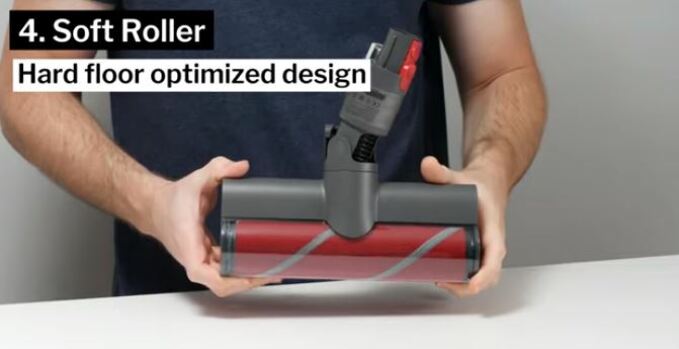
When it comes to carpet surface-level debris, the Dyson direct drive style cleaner head, due to the front clearance of the cleaner head, and the Shark DuoClean cleaner head, due to it having a soft roller at the front of the head, are the best cleaner heads for picking up larger debris on carpet. For medium and small-sized debris, cleaner head design is not as important. When it comes to carpet deep cleaning, airflow, suction, and cleaner head design, again, are the most prominent factors impacting performance.
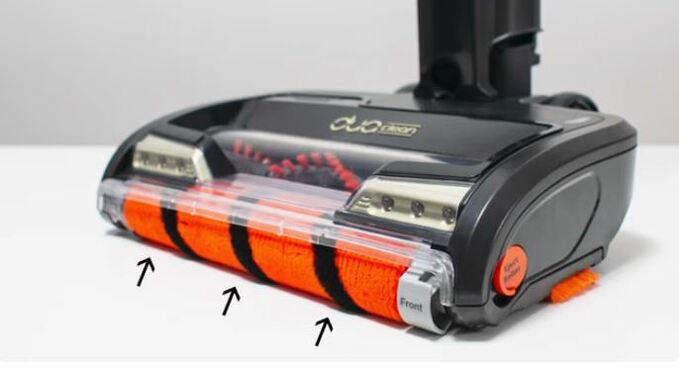
And again, the higher the airflow and suction, the better the chance of the vacuum performing well, this time deep cleaning carpet. Here are the test results for our carpet deep cleaning test. As you look at the chart here, it’s important to note that we didn’t test for deep cleaning using traditional methods. Traditionally, carpet deep clean testing involves pushing a vacuum over a patch of carpet very slowly for up to 20 passes. Our deep clean test involves pushing the vacuum at a regular everyday cleaning pace for only three passes. Our testing was set up in this way to be more indicative of real-world usage.

We didn’t want to test for a theoretical best-case scenario, as the traditional test does. Instead, we wanted to test how well the vacuum could deep clean without the user having any intention of deep cleaning. This is after all how you’re going to use the vacuum most of the time. Most of the time, you’re just going to use it regularly without any intention of deep cleaning, and we wanted to test how well the vacuum could clean from the top down to the bottom of the carpet fibers under such everyday conditions.
Hard floor cleaning performance
Once again, moving on to hard floor cleaning performance. Cleaning hard floors requires not only cleaning visible debris, in other words, debris that you can see, but also cleaning non-visible fine debris, in other words, fine dust that you may not be able to see.

Again, airflow, suction, and cleaner head design all play a role in performance. And when it comes to hard floor visible surface-level debris, you once again want as much airflow and suction as possible. The Shark DuoClean cleaner head, and especially soft roller cleaner heads, are the best cleaner heads for picking up larger debris on hard floors. For smaller-sized debris, cleaner head design is once again not as important.
Factors impacting hard floor Non-visible debris pickup
Non-visible fine debris pickup requires the vacuum to get a good seal for maximum suction. Our crevice test shows how well the vacuum can seal to the floor. The better the vacuum performs in this test, the better it is able to seal for maximum suction, which increases its ability to pick up non-visible fine debris on hard floors.
Best and worst sealing cordless vacuums
Here is a list of the best and worst sealing cordless vacuums on the market, according to our testing.
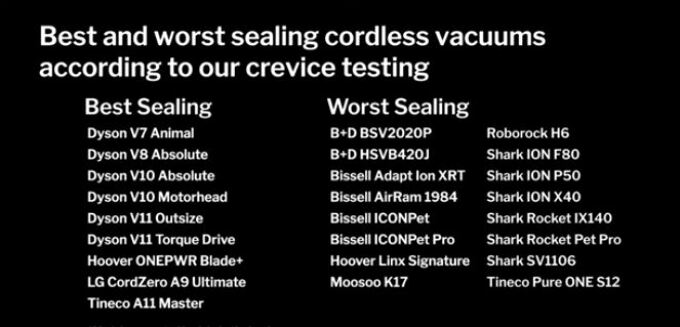
So far, we’ve only discussed picking up debris, but in order to clean properly, a good cordless vacuum needs to be able to do more than just pick up debris.
Debris containment
It also needs to be able to keep the debris it picks up contained within the vacuum. To ensure the debris stays contained within the vacuum, most cordless vacuums have a number of seals and at least two filters: a pre-motor filter and a post-motor filter. The pre-motor filter is optimized for removing larger particles from the air and particle stream that travels through the vacuum. The post-motor filter is optimized for removing smaller particles.

The post-motor filter is especially important because it represents the last line of defense against particles exhausting out of the vacuum. If the post-motor filter is unable to remove any remaining particles from the air that travels through the vacuum, those particles will exhaust out of the vacuum, get into the air surrounding the vacuum, and eventually fall to the surface where the vacuum picked them up from to begin with.
Obviously, you want a vacuum equipped with a post-motor filter that’s going to prevent this from happening. And the best way to ensure that you get a vacuum with a post-motor filter that will prevent this from happening is to buy a vacuum equipped with a HEPA post-motor filter, a filter that can remove up to 99.97 percent of particles 0.3 microns or larger from the air that travels through the vacuum. In the air purifier world, HEPA filtration is the gold standard for particle filtration, and the same applies here when it comes to post-motor filters for cordless vacuums.

You absolutely want to buy a cordless vacuum equipped with a HEPA post-motor filter. Though you need to be careful about which specific brands you trust when they claim that their vacuum is equipped with a HEPA post-motor filter. Certain budget brands have caught on that HEPA is the standard that consumers are looking for and have marketed their vacuums as having HEPA filters, regardless of whether they actually have HEPA filters or not. Now, you can certainly trust big brands like Dyson, Hoover, Bissell, and Shark when it comes to filtration specifications. But definitely be wary of lesser-known brands that are newer to the market.
This particular model, for example, from a lesser-known budget brand is marketed as having a HEPA filter. We think it’s safe to say that it most likely does not. According to these test results, all of the other cordless vacuums we tested with a HEPA filter pass the same test without issue.
Filtration and sealing test results
Here are the complete filtration and sealing test results for all of the 20 plus cordless vacuums we bought for review.

The next most important topic we need to discuss is cordless vacuum battery life. And here you once again have to be careful when looking at manufacturer specifications. Manufacturers tend to specify battery life for best-case scenarios. For example, they might specify battery life for when the vacuum is used in handheld mode, on low power, since it uses less power in handheld mode with no cleaner head connected to the vacuum and especially on a lower power mode, this gives the best battery life possible for the vacuum. The numbers look great from a marketing perspective, but they’re not very helpful to you because they don’t describe how you will actually use the vacuum most of the time.

Other vacuum review articles try to combat these issues by specifying tested battery life with the cleaner head attached and with it removed on different floor types and on different power settings, comparing consistent battery life numbers under consistent real-world conditions. This gives you more information to work with. But this is still not sufficient information to properly evaluate battery life.
Battery life vs carpet deep cleaning performance
You need additional information, additional context, to properly compare the battery life of one cordless vacuum versus another. That context is how well the cordless vacuum actually works in the real world at its specified battery life. If a particular model has great battery life but offers poor real-world performance, its great battery life is essentially a moot point.
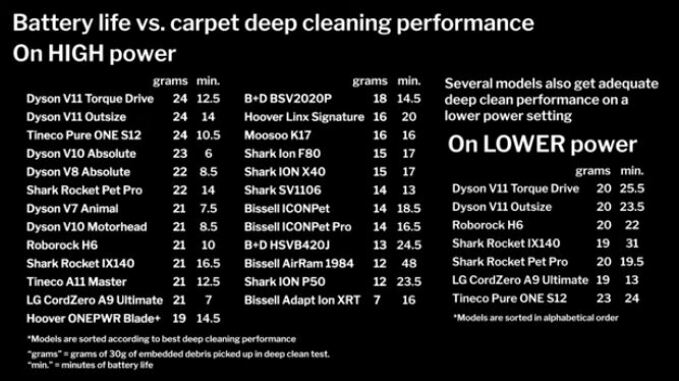
That’s why we always evaluate battery life relative to real-world performance, more specifically, we evaluate battery life within the context of the vacuum’s performance in our carpet deep cleaning test. Here is the battery life versus the carpet deep cleaning performance for all the cordless vacuums we tested.
Now, at the most fundamental level, cleaning performance, including debris pickup and containment, and battery life, are what matters most when it comes to choosing which specific cordless vacuum to buy. But that’s not to say that there aren’t at least a few other features that you should also look out for. Let’s take a quick look at those before we get to our model-specific recommendations. First, we have dust bin size.
Dust bin size
And when it comes to dust bin size, you once again have to be careful when looking at manufacturer’s specifications. Manufacturers often list bin size in terms of the overall volume of the bin. We measured bin size in terms of the volume of debris that the bin can hold up until the debris reaches the bin’s maximum fill line.
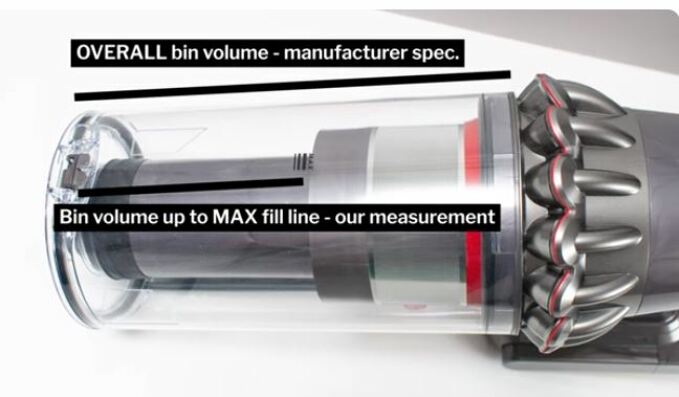
This volume is often less than the overall volume of the bin specified by many manufacturers. It’s also important to note that most cordless vacuums have very small bins that fill up extremely fast, especially if you vacuum a lot of debris or large debris that takes up a lot of space in the bin, like pet hair, for example. You really want to buy a vacuum with as large of a bin as possible. This chart shows the maximum measured bin capacity of all the cordless vacuums we tested.
Weight in hand
Another important feature to consider is the vacuum’s weight in your hand as you’re vacuuming. Manufacturers tend to describe weight in terms of the overall weight of the vacuum. This doesn’t really describe how light or heavy the vacuum feels in your hand while you’re vacuuming. We measured overall weight, but we also measured and put emphasis in our reviews on weight in the hand. This is a much better metric for describing how easy the vacuum is to handle and maneuver. This chart shows the measured weight in the hand for all the cordless vacuums we tested.

Model specific recommendations
Finally, let’s go over model specific recommendations for cordless vacuums. The best cordless vacuum we tested is the Tineco A11. The A11 has good airflow and suction and a well-designed cleaner head to allow it to pick up surface-level debris on carpet just about as quickly and efficiently as you can pick it up with a cordless vacuum.
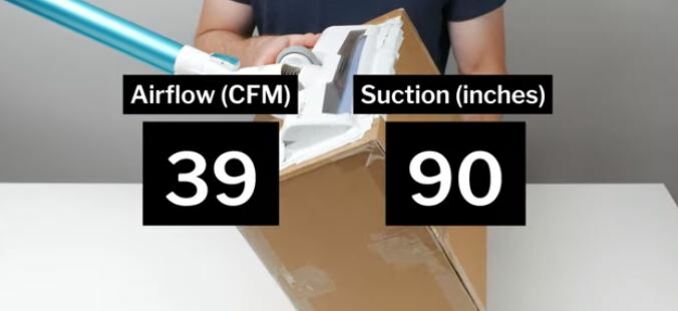

The same attributes, good airflow and suction, and a well-designed cleaner head also allow it to deep clean carpet very well. Its standard cleaner head did struggle a bit picking up larger debris on hard floors, though the same was the case for most other cordless vacuums we tested, and a soft roller cleaner head is readily available for the A11, either included with certain sub-models or for purchase at a reasonable price separately from the vacuum itself.
With a soft roller cleaner head installed, the A11 has no trouble picking up larger debris and cleans hard floors just about as well as any cordless vacuum we tested. Rounding out its hard floor performance, the A11 was a top performer in our crevice test, both with its standard cleaner head and with a soft roller cleaner head installed. When it comes to filtration and sealing, we don’t have any complaints with the A11. It has a HEPA post-motor filter and, as such, passed our filtration and sealing test without issue. When it comes to battery life, the A11 offers a great combination of battery life and performance, better than that of any other cordless vacuum in the same price range and even better than certain more expensive cordless vacuums we tested. All sub-models of the A11 also have an easily removable and swappable battery, and a few sub-models actually come with an extra battery.
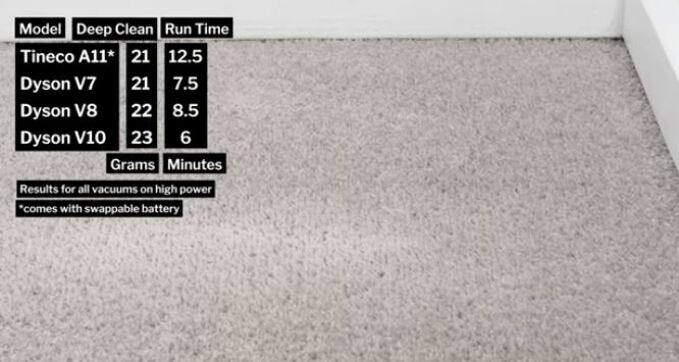
These are all features you just don’t get with most other cordless vacuums in the same price range and sometimes don’t even get with more expensive cordless vacuums. The A11 also has a large dust bin and is light, compact, and very easy to use. But most importantly, it gives you all of this at a very competitive price point. There are better-performing cordless vacuums on the market, but all of these vacuums are considerably more expensive than the A11, and we don’t think they offer nearly enough of a difference in performance and features to justify their much higher price compared to the A11. The A11 gets the title as the best cordless vacuum we tested because it offers everything you want in a cordless vacuum at a great value.

This is why the A11 is the cordless vacuum we recommend for most applications for most people. The Dyson V11 Outsize is the best upgrade option. The V11 Outsize offers the very best all-around performance of any cordless vacuum we tested, even better than that of the A11, but at a much higher price point than the A11. Compared to the A11, the V11 Outsize offers better carpet deep cleaning performance and better battery life and performance. It also has a much wider cleaner head and a much larger dust bin. If you want the best of the best and you don’t mind paying for it, the V11 Outsize is what you’re looking for.
So in summary, the Tineco A11 is our top recommendation as the best cordless vacuum for most people, and the Dyson V11 Outsize is our recommendation as the best cordless vacuum outside of price and value.
